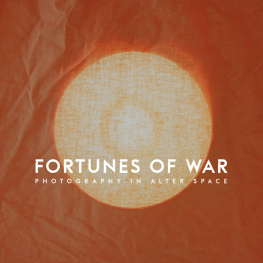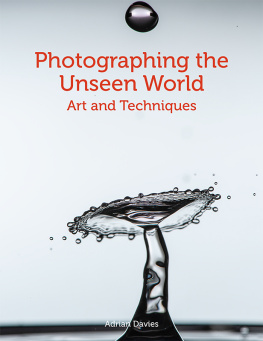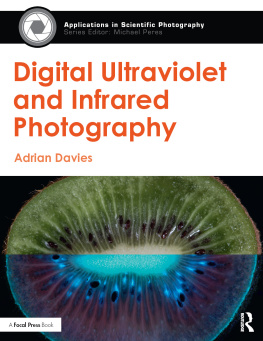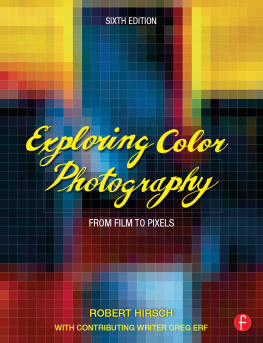Prutchi - Exploring Ultraviolet Photography
Here you can read online Prutchi - Exploring Ultraviolet Photography full text of the book (entire story) in english for free. Download pdf and epub, get meaning, cover and reviews about this ebook. year: 2016, publisher: Perseus Books, LLC, genre: Home and family. Description of the work, (preface) as well as reviews are available. Best literature library LitArk.com created for fans of good reading and offers a wide selection of genres:
Romance novel
Science fiction
Adventure
Detective
Science
History
Home and family
Prose
Art
Politics
Computer
Non-fiction
Religion
Business
Children
Humor
Choose a favorite category and find really read worthwhile books. Enjoy immersion in the world of imagination, feel the emotions of the characters or learn something new for yourself, make an fascinating discovery.

- Book:Exploring Ultraviolet Photography
- Author:
- Publisher:Perseus Books, LLC
- Genre:
- Year:2016
- Rating:3 / 5
- Favourites:Add to favourites
- Your mark:
- 60
- 1
- 2
- 3
- 4
- 5
Exploring Ultraviolet Photography: summary, description and annotation
We offer to read an annotation, description, summary or preface (depends on what the author of the book "Exploring Ultraviolet Photography" wrote himself). If you haven't found the necessary information about the book — write in the comments, we will try to find it.
Prutchi: author's other books
Who wrote Exploring Ultraviolet Photography? Find out the surname, the name of the author of the book and a list of all author's works by series.
Exploring Ultraviolet Photography — read online for free the complete book (whole text) full work
Below is the text of the book, divided by pages. System saving the place of the last page read, allows you to conveniently read the book "Exploring Ultraviolet Photography" online for free, without having to search again every time where you left off. Put a bookmark, and you can go to the page where you finished reading at any time.
Font size:
Interval:
Bookmark:
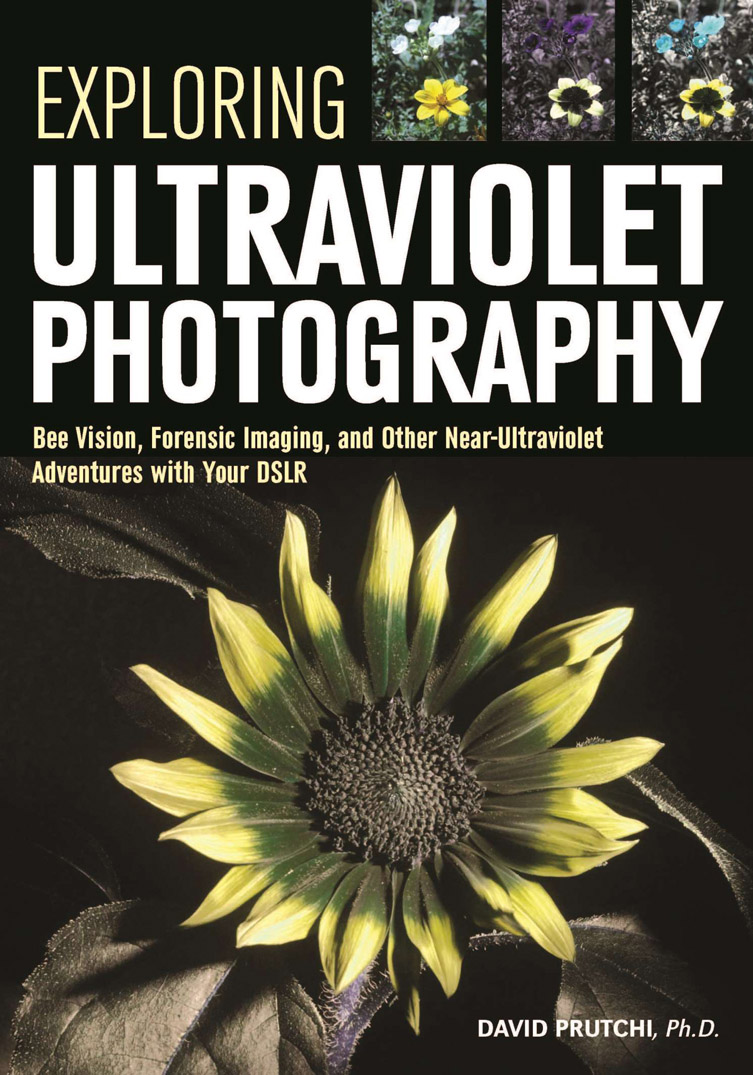

AUTHOR A BOOK WITH AMHERST MEDIA!
Are you an accomplished photographer with devoted fans? Consider authoring a book with us and share your quality images and wisdom with your fans. Its a great way to build your business and brand through a high-quality, full-color printed book sold worldwide. Our experienced team makes it easy and rewarding for each book soldno cost to you. E-mail today!
FRONT COVER(small photos)Bidens and petunias photographed in their natural environment under sunlight. Taken with a modified Canon T1i and EL Nikkor 80 mm f/5.6 enlarger lens mounted on a M39 focusing helicoid. Filters: X-Nite CC1 (left); Baader U (center); Schott UG-5 and S8612 glass panes (right).
FRONT COVER(large photo)Perennial sunflower photographed with a modified Canon T1i with an Asahi Takumar 35mm f/4 lens and filter made by stacking Schott UG-5 and S8612 glass panes. This was illuminated by a Vivitar 285HV flash, converted to full-spectrum output.
Copyright 2017 by David Prutchi.
All rights reserved.
All photographs by the author unless otherwise noted.
Published by:
Amherst Media, Inc., PO Box 538, Buffalo, NY 14213
www.AmherstMedia.com
Publisher: Craig Alesse
Senior Editor/Production Manager: Michelle Perkins
Editors: Barbara A. Lynch-Johnt, Beth Alesse
Acquisitions Editor: Harvey Goldstein
Associate Publisher: Kate Neaverth
Editorial Assistance from: Carey A. Miller, Sally Jarzab, John S. Loder, Roy Bakos
Business Manager: Adam Richards
ISBN-13: 978-1-68203-126-1
Library of Congress Control Number: 2016941019
10 9 8 7 6 5 4 3 2 1
No part of this publication may be reproduced, stored, or transmitted in any form or by any means, electronic, mechanical, photocopied, recorded or otherwise, without prior written consent from the publisher.
Notice of Disclaimer: The information contained in this book is based on the authors experience and opinions. The author and publisher will not be held liable for the use or misuse of the information in this book.

www.facebook.com/AmherstMediaInc
www.youtube.com/AmherstMedia
www.twitter.com/AmherstMedia
Table of Contents
Contents

A multispectral dusk quadriptych of Commerzbank Tower in downtown Frankfurt viewed from the Eiserner Steg (the Iron Footbridge) across the Main River. The panels at left, from top to bottom: show the visible light, infrared (Hoya R72 720 nm long-pass), and near-UV (Baader-U) images. The main panel is a multispectral composite with the combined visible channels assigned to red, IR to green, and UV to blue. The images were aligned with SIFT Flow algorithm. The photographs were taken with a modified Canon T1i camera and an Asahi Takumar 35mm f/4 lens.

The mouth is a carving on one of the corners of the Three-Windowed Temple in Machu Picchu, Peru. It held a wooden beam that supported the buildings roof. This photograph was taken with a modified Canon T1i camera and an Asahi Takumar 35mm f/4 lens with a Baader-U filter. It was white-balanced in Canon Digital Photo Professional against the wall rocks in the background. The saturation of the sky and mountains was increased in Photoshop Elements.
D avid Prutchi received his Ph.D. in engineering from Tel-Aviv University in 1994, and then conducted postdoctoral research at Washington University. His area of expertise is the development of active implantable medical devices and he is the Executive Vice President of Engineering at Impulse Dynamics. He is an adept do-it-yourselfer and avid photographer dedicated to bringing cutting-edge experimental physics and technical photography within the grasp of fellow buffs.
Dr. Prutchi has published over thirty papers and holds over seventy patents. He is the lead author of the book Design and Development of Medical Electronic Instrumentation: A Practical Perspective of the Design, Construction and Test of Medical Devices (John Wiley & Sons, 2004) and co-author of Exploring Quantum Physics through Hands-On Projects (John Wiley & Sons, 2012).
The real voyage of discovery consists not in seeking new landscapes, but in having new eyes.Marcel Proust
O n a sunny morning in February 1800, astronomer Sir William Herschel was testing various filters in preparation for observing sunspots when he noticed different amounts of heat passing through various colored filters, making him think that each color may itself have a characteristic temperature.

His discovery of infrared radiation showed that there are types of light that we cant see.
Curious about this idea, Herschel split a beam of sunlight through a glass prism and measured the temperature at the location of each color in the projected rainbow. His blackened-bulb thermometers showed an increase in temperature as he moved the thermometer from the violet, through the blue, green, yellow, orange, and into the red portion of the spectrum. Much to Herschels surprise, the temperature just beyond the red portion of the spectruma region where no light was apparently projected by the prismhad the highest temperature of all.
Further experimentation led Herschel to conclude that an invisible form of light must exist beyond the red portion of the color spectrum. Herschel named the radiation calorific rays. Although his hunch about temperature was not correct, his discovery of infrared radiation showed that there are types of light that we cant see.
A year later, in 1801, Johann Ritter, a science student at the University of Jenna, was experimenting with silver chloride, a chemical that turned black when exposed to sunlight. Ritter had heard that this chemical, which more than a decade later would be used to make the very first photograph, reacted more strongly when exposed to blue light than to red light. Like Herschel, Ritter used a glass prism to split a ray of sun, and then placed silver chloride under each color of the spectrum. Ritter noticed that the silver chloride showed little change in the red part of the spectrum but increasingly darkened toward the violet end of the spectrum. To his amazement, the strongest reaction happened well beyond the violet cutoff, where no visible light could be seen. Johann Ritter called the invisible radiation beyond violet chemical rays. Today, this portion of the electromagnetic spectrum is known as ultraviolet light.
Indeed, we now know that visible light is simply a type of electromagnetic wave, just like the enormously long waves that we use to transmit AC power, the radio wavelengths that are the foundation of our wireless society, and the extremely short wavelengths of gamma radiation. The only difference between visible light and the rest of the spectrum is that it is the range of electromagnetic waves that our eyes can see (; next page).
Font size:
Interval:
Bookmark:
Similar books «Exploring Ultraviolet Photography»
Look at similar books to Exploring Ultraviolet Photography. We have selected literature similar in name and meaning in the hope of providing readers with more options to find new, interesting, not yet read works.
Discussion, reviews of the book Exploring Ultraviolet Photography and just readers' own opinions. Leave your comments, write what you think about the work, its meaning or the main characters. Specify what exactly you liked and what you didn't like, and why you think so.


